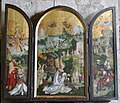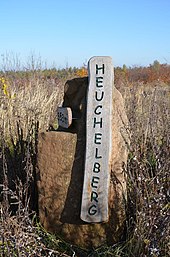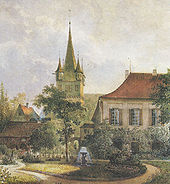Schwaigern
| coat of arms | Germany map | |
|---|---|---|
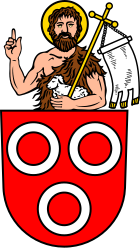
|
Coordinates: 49 ° 8 ' N , 9 ° 3' E |
|
| Basic data | ||
| State : | Baden-Württemberg | |
| Administrative region : | Stuttgart | |
| County : | Heilbronn | |
| Height : | 197 m above sea level NHN | |
| Area : | 49.48 km 2 | |
| Residents: | 11,425 (Dec. 31, 2018) | |
| Population density : | 231 inhabitants per km 2 | |
| Postal code : | 74193 | |
| Area code : | 07138 | |
| License plate : | HN | |
| Community key : | 08 1 25 086 | |
| LOCODE : | DE SWF | |
| City structure: | Core city and 3 districts | |
City administration address : |
Marktstrasse 2 74193 Schwaigern |
|
| Website : | ||
| Mayoress : | Sabine Rotermund | |
| Location of the city of Schwaigern in the Heilbronn district | ||
Schwaigern is a city in the district of Heilbronn in Baden-Württemberg . It belongs to the Heilbronn-Franconia region (until May 20, 2003 Franconia region ) and the peripheral zone of the European metropolitan region of Stuttgart .
geography
Schwaigern is located in the west of the Heilbronn district on the foothills of the Heuchelberg in the valley of the Lein , a left tributary of the Neckar .
Neighboring communities
Neighboring cities and communities of Schwaigern are ( clockwise , starting in the east) Leingarten , Nordheim , Brackenheim , Eppingen , Gemmingen , Massenbachhausen (all districts of Heilbronn) and the independent city of Heilbronn . Schwaigern has entered into an agreed administrative partnership with Massenbachhausen .
City structure
| district | Incorporation | Residents | surface |
|---|---|---|---|
| Schwaigern | - | 6170 | 22.06 km² |
| Massenbach | July 1, 1971 | 1888 | 8.50 km² |
| Niederhofen | Sept 1, 1971 | 925 | 7.81 km² |
| Stetten | Sept 1, 1971 | 2001 | 11.13 km² |
Schwaigern consists of the core town of Schwaigern and the districts of Massenbach , Niederhofen and Stetten am Heuchelberg . Schwaigern itself still includes the courtyards Lachenhöfe, Marienhof and Römerhöfe, the residential areas Obere Mühle and Untere Mühle (Freudenmühle) and the districts of Birkenhöfe, Lerchenberghöfe and Waldweghöfe, to Niederhofen the residential areas Fuchsberg and Ottilienhöfe, to Stetten the residential areas Bahnhof and Obere Mühle as well as the Districts Dinkelsklingenhöfe, Forchenwaldhöfe, Hornbuschhöfe and Sonnenberghöfe. Locations that have been lost and no longer exist today are on the Massenbach Wilhelmstal mark, Niederhofen Rindshof mark, Schwaigern Dissingen and Hochstetten mark (both merged in Schwaigern) and Waldbruderhaus.
Division of space

According to data from the State Statistical Office , as of 2014.
history
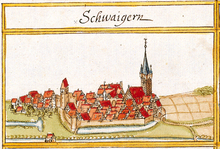
Archaeological finds from the Neolithic and Roman times indicate an early settlement of the Schwaigerner area. Schwaigern was first mentioned in 766 in a document from the Lorsch Codex . The place originally belonged to the Gartachgau . In the early 12th century the noble lords of Schwaigern are mentioned as local lords, who were replaced in the 13th century by the lords of Neipperg , who probably emerged from it , who had a clever alliance and wedding policy with the Kraichgau knighthood, Württemberg, the Electoral Palatinate and Baden and, from the 18th century, especially with the House of Habsburg, rose to great importance and always had one of their administrative centers in Schwaigern.
In 1188 an allodium (dt .: own property) in Sueigren is mentioned in a contract between Emperor Friedrich I Barbarossa and King Alfonso VIII of Castile , in which the marriage of Friedrich's son Konrad with Alfons daughter Berengaria was agreed. This property in Schweigern was part of the bride's morning gift along with 29 other Hohenstaufen goods . However, this marriage was never put into practice.
In 1486 the place received market rights. After 1630 the place was hit several times by the plague , which killed many residents. In 1690, during the War of the Palatinate Succession, the former Schwaigerner castle was burned down. The castle in Schwaigern, built around 1702, became the headquarters of the Lords of Neipperg, who were elevated to the rank of imperial count in 1726. In 1806 Schwaigern became part of the Kingdom of Württemberg through mediatization and was assigned to the Brackenheim District Office. In 1878, with the opening of the first section of the Kraichgau Railway from Heilbronn towards Eppingen , Schwaigern was connected to the railway network of the Württemberg Railway . In the 19th and 20th centuries, several large fires destroyed large parts of the medieval city center . In 1938, as part of a regional reform in Württemberg during the Nazi era , Schwaigern came to the Heilbronn district . Since Schwaigern had become part of the American zone of occupation after the Second World War , the city had belonged to the newly founded state of Württemberg-Baden since 1945 , which was merged into the current state of Baden-Württemberg in 1952. In 1971, on July 1st, Massenbach and on September 1st, Stetten am Heuchelberg and Niederhofen are incorporated.
Religions
Schwaigern has been predominantly evangelical since the Reformation . The most important church building in the area is the Protestant Johanneskirche . In Schwaigern, Stetten and Niederhofen there are separate Protestant parishes ; there is a joint Protestant parish for Massenbach and Massenbachhausen . The Protestant congregations all belong to the Evangelical Church in Württemberg in the church district of Brackenheim . The (Protestant-Pietist) Liebenzeller Community maintains its own groups in all three Protestant parishes in the city. An Evangelical Free Church ( Baptist ) congregation has existed in Massenbach since 1882 . The Catholic parish of St. Martinus Schwaigern is responsible for Stetten, Niederhofen and Neipperg (part of Brackenheim) in addition to Schwaigern, and the Catholic parish of St. Kilian Massenbachhausen for Massenbach and Massenbachhausen. The New Apostolic Church is also represented with a parish in Schwaigern.
The EC-Jugendbund has local groups in Schwaigern, Stetten and Niederhofen, the Liebenzeller Community in Schwaigern and Niederhofen, and the Evangelical Youth Organization Württemberg in Schwaigern and Stetten. The Christian Association of Young People (CVJM) Massenbach / Massenbachhausen is represented in Massenbach.
politics
Municipal council
The municipal council in Schwaigern has 22 members. The local elections on May 25, 2014 led to the following official final result. The municipal council consists of the elected voluntary councilors and the mayor as chairperson. The mayor is entitled to vote in the municipal council.
| Parties and constituencies |
% 2014 |
Seats 2014 |
% 2009 |
Seats 2009 |
||
| FWV / BuW | Free voters / farmers and wine growers | 34.3 | 8th | 35.9 | 10 | |
| CDU | Christian Democratic Union of Germany | 28.3 | 6th | 25.3 | 7th | |
| SPD | Social Democratic Party of Germany | 23.9 | 3 | 22.9 | 4th | |
| LGU | List of Greens and Independents | 13.5 | 3 | 15.8 | 4th | |
| total | 100.0 | 22nd | 100.0 | 27 | ||
| voter turnout | 51.5% | 54.1% | ||||
City schools and mayor in Schwaigern
- Friedrich Benzlen (1826–1868)
- August Liomin (1868-1893)
- Karl Essich (1893–1918)
- Max Neunhoeffer (1919–1933)
- Karl Spingler (1933–1939)
- Fritz Siegele (1941–1945)
- Friedrich Vogt (1945–1954)
- Hellmut Zundel (1954–1963)
- Horst Haug (1963-1999)
- Johannes Hauser (1999-2015)
- Sabine Rotermund (since 2015)
Source:
badges and flags
The blazon of the Schwaigern coat of arms reads: Three (2: 1) silver rings in red. Shield holder: St. John the Baptist with a golden nimbus and natural fur growing above the shield, his right hand pointing upwards, his left hand holding the natural lamb of God and the oblique left golden cross with a silver flag with three laces. The city colors are red and white.
The three silver rings on a red background are the coat of arms of the Counts of Neipperg and are also documented as Schwaigern stains for 1684 . John the Baptist as a shield holder is the patron of the Schwaigerner church. The coat of arms can be proven in this form in seal impressions from 1591, which were probably made with a seal made in 1512. A mayor's office seal from around 1820 only shows the coat of arms with the three rings without a shield holder, which was recorded in 1959 as the actual city arms, but according to the Schwaigern tradition, it is usually shown with John the Baptist as a shield holder. The colors of the city flag were set in 1925.
Partner communities
Schwaigern's partner communities have been the Austrian community of Pöndorf in Upper Austria (with a district called Schwaigern) since 1988 , the French community of La Teste-de-Buch in the Gironde department since 2004 and the Swiss community of Nottwil in the canton of Lucerne since 2009 .
Culture and sights
Buildings
- The Castle Schwaigern was from 1702 instead of 1690 destroyed the former stronghold for Field Marshal Friedrich Eberhard von Neipperg built in the 19th century by Gottlob Georg Barth and Christian Friedrich von Leins to wings and a chapel added to its present form. A farm yard and a park are adjacent to the four-winged castle.
- The Protestant Johanneskirche (town church) dates back to a building from the 13th century and was significantly expanded in the 16th century (by the master builder Bernhard Sporer ). Inside are the Barbara altar by Jerg Ratgeb, built in 1510, as well as the high altar and carved altars. Historical tombstones and epitaphs of the Counts of Neipperg are set up on the inner walls. Richard Rensch built the organ in 1984.
- City church of Schwaigern
- The town hall of the town was built by Theodor Moosbrugger after the town fire in 1905 and has Art Nouveau style elements in particular on the southeast bay and the entrance area . The nearby historic Rentamt was also renewed after the fire and connected to a neighboring half-timbered house with a central building in the late 20th century.
- The so-called Hexenturm on the southeastern edge of the medieval city is a defensive tower from 1461, which later served as a prison. The tower got its name from Anna Maria Heinrich, who was imprisoned here in 1713, accused of being a witch and later burned at the stake. The tower was once given to the von Neipperg family as a city gift for the silver wedding anniversary of a count and was returned to the city of Schwaigern in 1986, whereupon the tower was extensively renovated. Together with the attached Reinwald house from the 17th century, it forms an attractive ensemble. Another remnant of the former city fortifications is the nearby guard house in Pfarrstrasse, which uses parts of the city wall as foundation walls, including a round tower built over with a polygonal half-timbered tower. The Helferhaus from 1769 is also located on Pfarrstrasse. The baroque building was once used as the town's second rectory. Further remains of the medieval city fortifications have been preserved, especially in the west of the town center.
- The former city press is a half-timbered building from 1659, which was initially built as a wine press for the Counts of Neipperg and came into the possession of the city in 1852. Wine was pressed there until 1949, and fruit juice until the 1970s. The building was later converted into a supermarket. Since 2010, the building has housed the Schwaigern media library and the Karl-Wagenplast-Museum.
- The stork's nest is the oldest surviving residential building in the city and was once part of a stately three-sided farm from the 15th / 16th centuries. Century. The building was extensively renovated from 1982 to 1984. The upper floors still show the original Alemannic half-timbered construction.
- The cemetery chapel is a neo-Gothic sacred building from 1870, in which the Karl-Wagenplast-Museum was located from 1982 to 2009.
- The Catholic St. Martin's Church is a contemporary building from 1964, which was extensively renovated in the 1990s. The church contains several historical art treasures (Romanesque crucifix, late Gothic tabernacle), the colored glass windows were designed by Josef de Ponte .
- The Frizhalle with a striking clapboard-clad wooden tower was built in 1887 as a gymnastics, assembly and festival hall with school and kindergarten rooms and named after the founder Ernst Friz († 1869), who bequeathed 100,000 guilders to the city.
Museums
- The local history museum Karl-Wagenplast-Museum in the new media library on Kelterplatz mainly shows archaeological exhibits from the Neolithic to the Middle Ages from the Leintal, which come from the excavations of the namesake and honorary citizen of Schwaig, Karl Wagenplast.
- There is a pharmacy museum in the cellar vault of the castle pharmacy on the market square, which is run by the Hauser family.
sport and freetime
TSV Schwaigern has existed since 1898 and was founded as a gymnastics club. In addition to the traditional gymnastics department, which houses an L-level for girls and boys, u. a. badminton, karate, chess and the very rare sport of gymnastics . The club has produced many important athletes, especially when it comes to the gym bike. In 1992 the tennis department (TC Schwaigern) and in 1993 the football department (FSV Schwaigern) became independent.
Schwaigern also has a heated outdoor pool.
With the Leintalzoo Schwaigern , Schwaigern has a zoo in which the largest cohesive group of chimpanzees in Germany can be seen.
The Schwaigern local group of the Swabian Alb Association , founded in 1908, was awarded the Eichendorff plaque in 2008 .
Regular events
Every year the Heuchelberg winery organizes the multi-day wine press festival on its premises in Schwaigern.
Economy and Infrastructure
The largest company based in Schwaigern is Walter Söhner GmbH & Co. KG, which manufactures plastic parts and employs over 500 people in Schwaigern. In addition, a large number of medium-sized companies are based in Schwaigern and its districts. Especially in Massenbach and Stetten, however, the basic supply and retail trade is falling sharply. Until the opening of a supermarket in Massenbach around the year 2000, there was no longer any shopping opportunities in this district.
The VBU Volksbank im Unterland , which emerged from the merger of several regional cooperative banks , has its headquarters in Schwaigern.
traffic
Light rail
Schwaigern has on the light rail Heilbronn traffic Kraichgaubahn ( Karlsruhe - Heilbronn ) over the three breakpoints Schwaigern-West, Schwaigern Schwaigern Station and East. From Schwaigern-West via Heilbronn to Weinsberg and Öhringen, the trains run every 20 minutes, one of which is an express train with fewer stops. In the direction of Karlsruhe there is a 30-minute cycle with one express train connection per hour. The Kraichgau Sprinter drives through all stops without stopping.
Street
The B 293 from Heilbronn to Karlsruhe also runs through Schwaigern. A connection to the federal autobahn 45 that was once planned did not materialize because the construction of the southern extension of the A 45 was abandoned in 1979.
media
The Heilbronner Voice is the only daily newspaper to report on what is happening in Schwaigern in its issue W, Landkreis West. You can find out a lot about this in the local newsletter for the city of Schwaigern. The regional advertising paper Leintal-Hits also contains news, especially from culture and sport.
Supply and disposal
The district of Heilbronn operated one of its two landfills in the Schwaigern district of Stetten, which was responsible for the western half of the district. The landfill in Eberstadt was responsible for the eastern district . Since June 1, 2005, no more household waste has been dumped due to the changed legal situation. This can still be delivered in small quantities, but like all other garbage from the community in Heilbronn, it is biomechanically processed and sorted. Only one recycling center is operated on the landfill site.
South of the landfill is the Heuchelberg landfill, the largest of currently nine landfills in the district. It was established in the mid-1980s on the site of an abandoned missile site of the US armed forces . The landfill covers an area of 18.5 hectares and has so far taken up around 900,000 m³ of soil. The overburden now forms the highest peak of the Heuchelberg with a height of 353 m above sea level. NN . The reforestation of the filled areas has been ongoing since 1999.
education
There are own primary schools in Schwaigern (Sonnenbergschule), Massenbach and Stetten, in Schwaigern there is also the Leintal- Hauptschule (with Werkrealschule ), the Leintal- Realschule and the Sonnenberg- Förderschule . The Volkshochschule Unterland has a branch in Schwaigern.
Viticulture
The viticulture in Schwaigern is first mentioned in 799th The main grape varieties grown are Trollinger , Riesling , Lemberger and Schwarzriesling . The Heuchelberg winery, the fourth largest winery in Baden-Württemberg, has its headquarters in Schwaigern. In addition to several other self- marketers, the Graf von Neipperg winery is particularly well known. The Württemberg wine queen 2007/2008, Mirjam Kleinknecht, comes from Schwaigern.
The district of Stetten offers a wide range of wines with three wineries and a wine cellar. A vine refinement lays the foundation for the varietal plants. With Claudia Rüber, Stetten presented the Württemberg wine queen in 1992.
The locations of all districts belong to the Heuchelberg area in the Württemberg wine-growing region .
Friedwald
Since July 27, 2005 there is a cemetery in Schwaigern , the first in Baden-Württemberg. After two years, over 400 people had been buried there and over 1,000 contracts had been signed.
Personalities
Honorary citizen
- Karl Wagenplast, local history researcher
- Horst Haug, Mayor of Schwaigern from 1962 to 1999
sons and daughters of the town
- Günther Heinrich von Berg (born November 27, 1765 in Schwaigern, † September 9, 1843 in Oldenburg), lawyer and politician, Oldenburg State and Cabinet Minister
- Erwin von Neipperg (born April 6, 1813 in Schwaigern; † March 2, 1897 ibid), Austrian general, member of the Chamber of Class Lords
- Alfred von Neipperg (born January 26, 1807 in Schwaigern; † November 16, 1865 in Winnenthal) Austrian cavalry master, Württemberg major general, member of the Chamber of Classes
- Michaela von Neipperg (born September 9, 1885 in Schwaigern; † April 7, 1957 in Konstanz), German countess and Benedictine
- Bruno Stark (born May 17, 1894 in Schwaigern; † April 17, 1979 in Stuttgart), painter, pupil of Adolf Hölzel
Personalities associated with the city
- Philipp Heinrich Haab (1758–1833), pastor for many years
- Josef de Ponte (1922–2006), Hungarian-German church painter, lived in Schwaigern from 1965
- Rainer Dahlem (* 1946), trade unionist and local politician (SPD), lives in Schwaigern
literature
- Schwaigern. Homeland book of the city of Schwaigern with the suburbs Massenbach, Stetten a. H. and Niederhofen . City administration Schwaigern, Schwaigern 1994
Individual evidence
- ↑ State Statistical Office Baden-Württemberg - Population by nationality and gender on December 31, 2018 (CSV file) ( help on this ).
- ↑ As of December 31, 2008. Figures, facts, statistics on schwaigern.de (accessed on September 27, 2009)
- ↑ Source for the urban structure section: Das Land Baden-Württemberg. Official description by district and municipality. Volume IV: Stuttgart district, Franconian and East Württemberg regional associations. Kohlhammer, Stuttgart 1980, ISBN 3-17-005708-1 , pp. 138–141 as well as supplements and corrections in Volume VIII, Stuttgart 1983, ISBN 3-17-008113-6 , p. 662.
- ↑ State Statistical Office, area since 1988 according to actual use for Schwaigern.
- ^ Peter Wanner: The Staufer-Castilian marriage pact of the year 1188. Findings on the occasion of some "small" district and community anniversaries in 2013 . In: Christhard Schrenk / Peter Wanner (eds.): Heilbronnica 6. Contributions to the city and regional history . Heilbronn 2016, pp. 453–460, here: pp. 458–459. PDF 366 kB.
- ^ Federal Statistical Office (ed.): Historical municipality directory for the Federal Republic of Germany. Name, border and key number changes in municipalities, counties and administrative districts from May 27, 1970 to December 31, 1982 . W. Kohlhammer, Stuttgart / Mainz 1983, ISBN 3-17-003263-1 , p. 450 .
- ↑ Statistisches Landesamt Baden-Württemberg, municipal election results 2014 ( page no longer available , search in web archives ) Info: The link was automatically marked as defective. Please check the link according to the instructions and then remove this notice.
- ^ Schwaigern: Homeland book of the city of Schwaigern with the sub-towns of Massenbach, Stetten a. H. and Niederhofen. City administration Schwaigern, Schwaigern 1994, p. 596.
-
^ Sources for the section coat of arms and flag:
Heinz Bardua: The district and community coat of arms in the Stuttgart administrative region. Theiss, Stuttgart 1987, ISBN 3-8062-0801-8 (district and community arms in Baden-Württemberg, 1), p. 124
Eberhard Gönner: Book of arms of the city and district of Heilbronn with a territorial history of this area. (= Publications of the State Archives Administration Baden-Württemberg. 9). Archive Directorate Stuttgart, Stuttgart 1965, p. 136. - ↑ Eckart Roloff , Karin Henke-Wendt: Small collection in an ancient cellar. (The pharmacy museum Schwaigern). In: Visit your doctor or pharmacist. A tour through Germany's museums for medicine and pharmacy. Volume 2: Southern Germany. Verlag S. Hirzel, Stuttgart 2015, ISBN 978-3-7776-2511-9 , pp. 73-74.
- ↑ Stimme.de
-
↑ Source of the Heuchelberg landfill:
Herbert Kaletta: 35,000 trees and a new peak . In: Heilbronn voice . April 11, 2011 ( from Stimme.de [accessed November 9, 2012]). - ↑ VHS Unterland branch offices .
- ↑ Reto Bosch: Many people want their ashes to be buried on tree roots. In: Heilbronn voice . July 23, 2007, p. 33.














